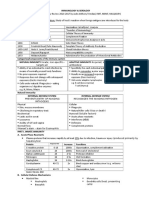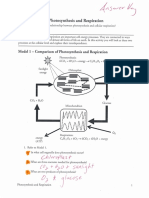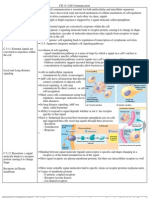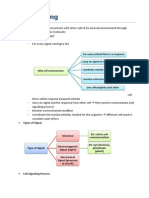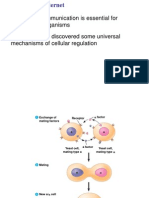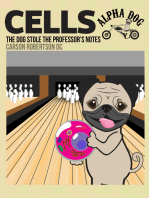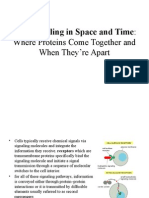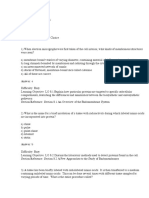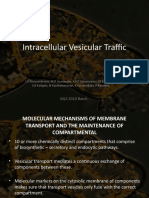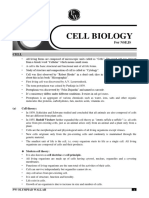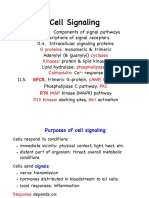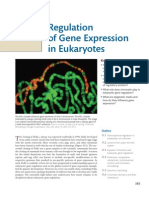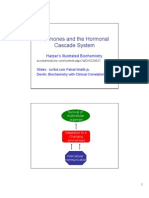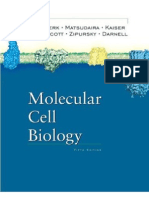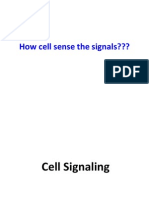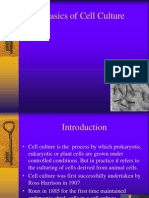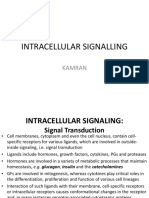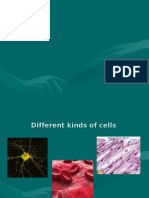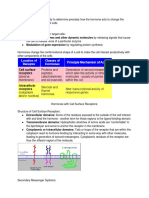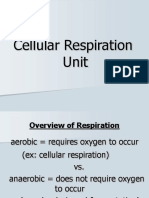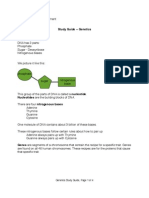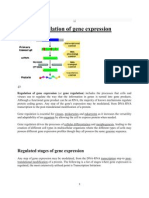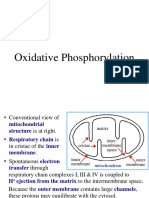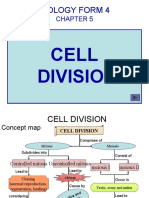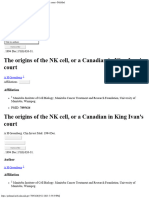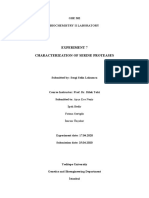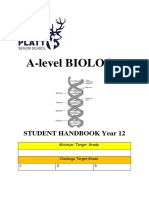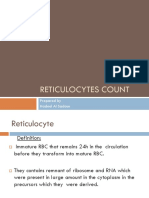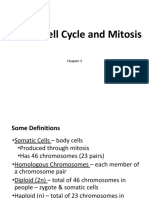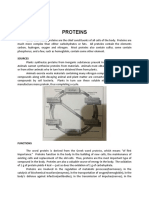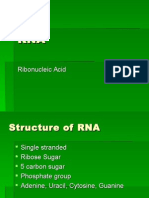Cell Communication Notes
Cell Communication Notes
Uploaded by
elyssaCopyright:
Available Formats
Cell Communication Notes
Cell Communication Notes
Uploaded by
elyssaCopyright
Available Formats
Share this document
Did you find this document useful?
Is this content inappropriate?
Copyright:
Available Formats
Cell Communication Notes
Cell Communication Notes
Uploaded by
elyssaCopyright:
Available Formats
Cell Communication Notes
- Cell Communication= External signals are converted into responses within the cell
o All cells (prokaryotes and eukaryotes) communicate Examples:
- Cells (in multicellular organisms) communicate by a variety of chemical signals. Some
examples are:
1. Hormones, such as insulin- Produced in one tissue, travel through bloodstream,
interact with certain cells to change cell activity.
2. Neurotransmitters, such as dopamine- Released by one nerve cell (neuron), travels
very short distance to adjacent neuron, stimulates nerve cell activity
Signal Transduction Pathways
- Convert signals on a cell’s surface into cellular responses
How do different organisms use cell communication?
Single cells- Yeast cells (Single Cells) identify their mates by cell signaling; bacteria respond to
population density
Multicellular Organisms-
o Examples:
1. Epinephrine stimulation of glycogen breakdown in mammals
2. Temperature determination of sex in some vertebrate organisms, such as some turtles,
American alligator, etc.
3. DNA repair mechanisms
- Cell Junctions- Multicellular Organisms- Plant and animal cells have cell junctions that
directly connect the cytoplasm of adjacent cells
- Direct contact- Animal cells; examples: Immune cells such as antigen-presenting cells
helper T-cells and killer T- cells.
- Local Regulators- Short distances. Animal cells; examples: Paracrine and Synaptic
- Long distance signaling- Both plants and animals use hormones; examples:
neurotransmitters, plant immune response, embryonic development, quorum (population
control) sensing in bacteria
Sutherland suggested that cells receiving signals went through three processes:
1. Reception
2. Transduction
3. Response
Reception- A signal molecule binds to a receptor protein, causing it to change shape
• The binding between signal molecule (ligand) and receptor is highly specific
• A conformational change in a receptor is often the initial transduction of the signal
• Intracellular receptors are cytoplasmic or nuclear proteins
• Signal molecules that are small or hydrophobic and can readily cross the plasma
membrane use these receptors
There are three main types of membrane receptors:
1. G-protein-linked receptors
2. Tyrosine kinases receptors
3. Ion channel receptors
G- Protein linked receptors
3 components- all allosteric proteins that that can change shape in response to signal:
1. Receptor proteins- spans plasma membrane, has receptor site on outside, binding site for
G-protein on inside
2. G- protein- loosely attached to inner membrane
a. Acts like on-off switch
b. Inactive form when bound to GDP
c. Active form when bound to GTP
d. G-protein soon breaks GTP down to GDP, so “on” stat switches back to “off”
3. Target- usually a membrane bound enzyme
a. Enzyme is inactive until activated by active G-protein
Examples that use G-proteins:
- Many hormone receptors
- Many neurotransmitters
- Vision and smell in humans
- Bacterial infections (botulism, cholera, etc.) produce toxins that interfere with G-
proteins, leading to disease symptons
- As many as 60% of all medicines sold today act by influencing G- protein pathways
Transduction- Cascades of molecular interactions relay signals from receptors to target
molecules in the cell
1. Protein Phosphorylation
- Multistep pathways- can amplify a signal and provide more opportunities for
coordination and regulation
- At each step in a pathway
– The signal is transduced into a different form, commonly a conformational change
in a protein
– Include phosphorylation cascades
- A series of protein kinases (enzymes) add a phosphate to the next one in line, activating it
– Phosphatase enzymes then remove the phosphates
– Kinases are often linked: Kinase 1 activates kinase 2, which activates kinase 3, etc
to final target.
2. Second Messengers
- Second messengers- are small, non-protein, water-soluble molecules or ions
- Example= cyclic AMP (cAMP)
- cAMP is made from ATP by enzyme adenyl cyclase (often activated by G-protein)
- cAMP acts like an intracellular hormone, stimulating variety of effects thatdiffers from
tissue to tissue
- Many G-proteins trigger the formation of cAMP, which then acts as a second messenger
in cellular pathways
- Ca++ is an important second messenger because cells are able to regulate its concentration
in the cytosol
- Other second messengers such as inositol triphosphate and diacylglycerol
• Can trigger an increase in calcium in the cytosol
Response: Cell signaling leads to regulation of cytoplasmic activities or transcription
• Cells use multi step pathways for amplification
• Each activated component can turn “on”, or activate multiple copies of many different
target molecules
• The more steps involved, the bigger the final number of activated products = activation
cascade.
• The different combinations of proteins in a cell give the cell great specificity in both the
signals it detects and the responses it carries out
• Other pathways regulate genes by activating transcription factors that turn genes on or off
• Signal response is terminated quickly by the reversal of ligand binding
Changes in Signal Transduction pathways can alter cellular response
- Conditions where signal transduction is blocked/defective
- Examples:
o Diabetes, heart disease, neurological disease, autoimmune disease, cancer, cholera
o Effects of neurotoxins, poisons, and pesticides
o Drugs
So why do we care?
• Allows humans to modify and manipulate biological systems and physiology.
• Human example: Knowing about the endocrine system allowed for the creation of birth
control pills and medicines to control blood pressure, depression, and metabolism
• Other examples: Agricultural production and modifying ripening in fruit
You might also like
- AS & A Level Biology Workbook AnswersDocument56 pagesAS & A Level Biology Workbook Answersღ꧁Lizzy X Roxiie꧂ღ90% (10)
- Immunology & Serology Review NotesDocument4 pagesImmunology & Serology Review Notesmaria email86% (7)
- Photosynthesis and Respiration PogilDocument6 pagesPhotosynthesis and Respiration Pogilelyssa100% (1)
- Ganong - Physiology Self-Assessment Questions - 01Document51 pagesGanong - Physiology Self-Assessment Questions - 01Shasheendra JayawickramaNo ratings yet
- 1 Cell CommunicationDocument33 pages1 Cell CommunicationKaye Macauba CentinoNo ratings yet
- CH 11 Cell CommunicationDocument4 pagesCH 11 Cell Communicationwil7ver100% (2)
- CH 45 Guided ReadingDocument7 pagesCH 45 Guided ReadingmharirajNo ratings yet
- CH 13 Guided Reading AP BioDocument4 pagesCH 13 Guided Reading AP BioKyle Schmidt50% (2)
- Cell SignallingDocument12 pagesCell SignallingRibka Kristania HadhiwaluyoNo ratings yet
- Unit 4 Cell CommunicationDocument74 pagesUnit 4 Cell CommunicationBerryNo ratings yet
- CH 11 PPT Cell Communication 1Document77 pagesCH 11 PPT Cell Communication 1api-270681964No ratings yet
- Cell Signalling Notes Merit Life Sciences1Document61 pagesCell Signalling Notes Merit Life Sciences1merit tutorials com NET JRF JAM TUTORIALSNo ratings yet
- Chapter 2.0 Cell Signalling and Endocrine RegulationDocument93 pagesChapter 2.0 Cell Signalling and Endocrine RegulationNurarief AffendyNo ratings yet
- Cell Signaling in Space and Time:: Where Proteins Come Together and When They're ApartDocument20 pagesCell Signaling in Space and Time:: Where Proteins Come Together and When They're ApartHumbertoNo ratings yet
- CH 11 PPT Cell CommunicationDocument46 pagesCH 11 PPT Cell CommunicationpalakNo ratings yet
- CH 08Document81 pagesCH 08Divine Grace InovejasNo ratings yet
- Ligand and Cell Signaling PathwaysDocument117 pagesLigand and Cell Signaling PathwaysShoaib MomenNo ratings yet
- Molecular Biology BIOL312Document273 pagesMolecular Biology BIOL312Paul GarciaNo ratings yet
- Intra Cellular Vesicular TrafficDocument48 pagesIntra Cellular Vesicular TrafficKanishkaNo ratings yet
- Cell CommunicationDocument25 pagesCell Communicationprehealthhelp100% (12)
- Cell - Structure & Function 02 - Theory Notes - PDF Only - NSEJS 2023Document38 pagesCell - Structure & Function 02 - Theory Notes - PDF Only - NSEJS 2023wigiye6232No ratings yet
- Signal TransductionDocument38 pagesSignal Transductionjuju100% (2)
- Cilia and FlagellaDocument25 pagesCilia and FlagellaLia Savitri RomdaniNo ratings yet
- Ch11 - Cell Signaling SlidesDocument36 pagesCh11 - Cell Signaling SlidesValine Cysteine MethionineNo ratings yet
- Regulation of Gene Expression in EukaryotesDocument30 pagesRegulation of Gene Expression in EukaryotesRohan Walking TallNo ratings yet
- Cell SignallingDocument72 pagesCell SignallingSheerin SulthanaNo ratings yet
- Cloning VectorsDocument161 pagesCloning Vectorssubhash nayak100% (2)
- Cellular Molecular BiologyDocument4 pagesCellular Molecular BiologyCpopNo ratings yet
- Overview of Cell Cycle by Javali.GDocument15 pagesOverview of Cell Cycle by Javali.GJavali.GNo ratings yet
- HormonesDocument13 pagesHormonesFaisal_Khatib_juNo ratings yet
- Cell Signaling NotesDocument4 pagesCell Signaling NotesSciencefun23No ratings yet
- Pages From 1-Molecular Cell Biology Lodish 5Th EdDocument4 pagesPages From 1-Molecular Cell Biology Lodish 5Th Edapi-3733156100% (1)
- Cell Cycle: SPEAKER-Dr - Ayesha.Juhi Coordinator-Dr - Ravindra.P.NDocument38 pagesCell Cycle: SPEAKER-Dr - Ayesha.Juhi Coordinator-Dr - Ravindra.P.NAyesha SKNo ratings yet
- Cell SignallingDocument37 pagesCell SignallingSreekarWunnava100% (1)
- Cell CommunicationDocument32 pagesCell CommunicationMajd MerieNo ratings yet
- Genetics: Revised Curriculum OFDocument44 pagesGenetics: Revised Curriculum OFAzzura Najmie Fajriyah Tamalate0% (1)
- Bio Lecture 2 Cell StructureDocument46 pagesBio Lecture 2 Cell StructureLương Bang NguyễnNo ratings yet
- Cell CultureDocument33 pagesCell CultureSai SridharNo ratings yet
- Signal Transduction and Gene Regulation in Plant DevelopmentDocument55 pagesSignal Transduction and Gene Regulation in Plant Developmentlordniklaus100% (1)
- Developmental BiologyDocument21 pagesDevelopmental BiologygahanNo ratings yet
- Human FertilizationDocument3 pagesHuman Fertilizationtamalbio7No ratings yet
- Intracellular SignallingDocument45 pagesIntracellular Signallingsana iqbalNo ratings yet
- Developmental Biology H. 277 - Gillbert BarresiDocument57 pagesDevelopmental Biology H. 277 - Gillbert BarresiAndini M RNo ratings yet
- Biology Chapter 8 - Cell CommunicationDocument8 pagesBiology Chapter 8 - Cell CommunicationDonnabelle VaronaNo ratings yet
- 2.4.1 Cell WallDocument17 pages2.4.1 Cell WallSyahirah SyerryNo ratings yet
- The Operon ModelDocument44 pagesThe Operon Modelfae-ar_raziNo ratings yet
- Cell Signaling: Lodish Pgs. 534, 600, 618-619Document14 pagesCell Signaling: Lodish Pgs. 534, 600, 618-619keeettsszNo ratings yet
- Mechanisms of Hormone Action NotesDocument3 pagesMechanisms of Hormone Action Notesapi-390361165No ratings yet
- Cellular Respiration 1Document28 pagesCellular Respiration 1Maria Flor PabeloniaNo ratings yet
- Biology - Questions & Answers CSIR NET Paper II Life-ScienceDocument112 pagesBiology - Questions & Answers CSIR NET Paper II Life-ScienceNikhil Zope100% (1)
- Stem Cell Plasticity-Building The Brain of Dreams: by Sally TempleDocument22 pagesStem Cell Plasticity-Building The Brain of Dreams: by Sally TempleGagan KarwarNo ratings yet
- Nucleus: Click To Edit Master Subtitle StyleDocument29 pagesNucleus: Click To Edit Master Subtitle StyleAzifah ZakariaNo ratings yet
- Genetics Study GuideDocument4 pagesGenetics Study Guidegmanb5100% (2)
- Genetics, Lecture 11 (Lecture Notes)Document16 pagesGenetics, Lecture 11 (Lecture Notes)Ali Al-QudsiNo ratings yet
- Regulation of Gene ExpressionDocument5 pagesRegulation of Gene ExpressionHanumat SinghNo ratings yet
- 11.1 Genetic Variation Within A PopulationDocument2 pages11.1 Genetic Variation Within A PopulationOmar AlwaerNo ratings yet
- Chapter 8 Lecture-Energy, Enzymes, and Metabolism-MODIFIED2Document49 pagesChapter 8 Lecture-Energy, Enzymes, and Metabolism-MODIFIED2E'Lasia Larkin100% (1)
- CSIR NET Life Science Important Topics CSIR NET Reference BooksDocument12 pagesCSIR NET Life Science Important Topics CSIR NET Reference BooksJigyasu bNo ratings yet
- Chapter 15 SummaryDocument27 pagesChapter 15 SummaryCharlotteNo ratings yet
- Oxidative PhosphorylationDocument47 pagesOxidative PhosphorylationSadaf BegNo ratings yet
- Science behind Non-specific Science: (For Molecular Biologist & Biotechnologist)From EverandScience behind Non-specific Science: (For Molecular Biologist & Biotechnologist)No ratings yet
- Thermodynamics Lecture PDFDocument404 pagesThermodynamics Lecture PDFelyssaNo ratings yet
- Thermodynamics Lecture PDFDocument404 pagesThermodynamics Lecture PDFelyssaNo ratings yet
- Maslow's Hierarchy of Needs Blindside ExDocument1 pageMaslow's Hierarchy of Needs Blindside ExelyssaNo ratings yet
- Cartilage LectureDocument31 pagesCartilage LecturemalyaaNo ratings yet
- Sri Lankan Biology Olympiad 2020Document12 pagesSri Lankan Biology Olympiad 2020Bhathika GamageNo ratings yet
- Cardio Slide AnatomyDocument25 pagesCardio Slide AnatomyMhd Ridho FahreziNo ratings yet
- 2.2 TCA CycleDocument14 pages2.2 TCA Cyclesabirinaly30No ratings yet
- WS1 - 11 Grade - The Genetic Code and DNA ReplicationDocument2 pagesWS1 - 11 Grade - The Genetic Code and DNA ReplicationMerey ZiyabekNo ratings yet
- Cell Structures and Their Functions SLADocument19 pagesCell Structures and Their Functions SLAMaricar Baria100% (2)
- Bio f4 Chap 5 Cell DivisionDocument30 pagesBio f4 Chap 5 Cell Divisionplj_jane6508No ratings yet
- AP Biology: Student Interactive Learning GuideDocument20 pagesAP Biology: Student Interactive Learning GuideA ForeverNo ratings yet
- The Origins of The NK Cell, or A Canadian in King Ivan's CourtDocument2 pagesThe Origins of The NK Cell, or A Canadian in King Ivan's Courthoangphuong08101992No ratings yet
- Plasma Proteins 1Document46 pagesPlasma Proteins 1Faisal_Khatib_juNo ratings yet
- Experiment 7 Characterization of Serine Proteases: GBE 302 Biochemistry Ii LaboratoryDocument8 pagesExperiment 7 Characterization of Serine Proteases: GBE 302 Biochemistry Ii LaboratoryDeniz YılmazNo ratings yet
- Biology A Level Handbook 2023Document34 pagesBiology A Level Handbook 2023uzair madanessNo ratings yet
- Cells - Vocabulary ListDocument2 pagesCells - Vocabulary ListBrandon ShevelevNo ratings yet
- 2.4 (Biochemistry) Tca HMP and Uronic Acid PathwayDocument15 pages2.4 (Biochemistry) Tca HMP and Uronic Acid Pathwaylovelots1234100% (2)
- General BiologyDocument17 pagesGeneral BiologyZyra Mae PaguintoNo ratings yet
- Prokariotik Dan Eukariotik 2Document22 pagesProkariotik Dan Eukariotik 2hanumNo ratings yet
- Institute of Organic Chemistry and Biochemistry, Czechoslovak Academy of Sciences, 166 10 Prague 6, CzechoslovakiaDocument4 pagesInstitute of Organic Chemistry and Biochemistry, Czechoslovak Academy of Sciences, 166 10 Prague 6, CzechoslovakiaJustine May Balinggan DelmasNo ratings yet
- Chapter 4 - Alberts - Bài 1+2Document64 pagesChapter 4 - Alberts - Bài 1+2Hùng TuấnNo ratings yet
- Reticulocytes Count: Prepared by Hadeel Al SadounDocument10 pagesReticulocytes Count: Prepared by Hadeel Al SadounAhmed GaberNo ratings yet
- Chapter 3 - Cell Cycle and MitosisDocument22 pagesChapter 3 - Cell Cycle and MitosisMae Angela MorenoNo ratings yet
- Apoptosis A Practical Approach Practical Approach SeriesDocument267 pagesApoptosis A Practical Approach Practical Approach SeriesSergiu PlescaNo ratings yet
- Proteins PDFDocument20 pagesProteins PDFDOMADO EBTISHAMNo ratings yet
- The General Formula of Monosaccharide IsDocument6 pagesThe General Formula of Monosaccharide IsUmerNo ratings yet
- Muscular System: Structure and Function: 1. Types of MusclesDocument3 pagesMuscular System: Structure and Function: 1. Types of MusclesIceLandNo ratings yet
- BIOL 409 Quiz #8 KEYDocument2 pagesBIOL 409 Quiz #8 KEYBellony SandersNo ratings yet
- Plasmodium Falciparum Is The Major ContributorDocument39 pagesPlasmodium Falciparum Is The Major Contributorkhokhar9764604No ratings yet
- RNA PowerPointDocument20 pagesRNA PowerPointAnki0391100% (1)

